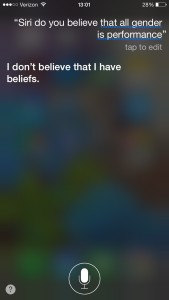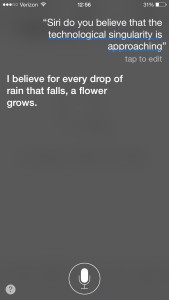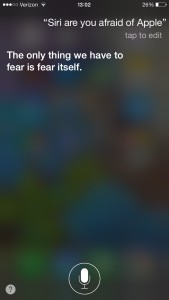PComp, Wk1: What is Interaction?
Prompt: After this class’ discussion and exercise, and reading Chris Crawford’s definition and Bret Victor’s rant, how would you define physical interaction? What makes for good physical interaction? Are there works from others that you would say are good examples of digital technology that are not interactive?
How would I define physical interaction? As much as I would like to posit myself as one of Crawford’s so-called future academics who hold the potential to develop a “high-quality” definition of physical interaction, I went back to graduate school to learn how to make things.
…That being said…with an anthropological background, I find it easy to comprehend Crawford’s metaphor of physical interaction being similar to a conversation (I always loved linguistics classes). However, is conversation the ur-form of interaction? I can’t help but try and make it more basic, to a form of meaningful gesture. I guess, at the end of the day, it is all about communication – whether it takes the form of words, gestures, sounds, etc.
Though –
I can’t help but think of interactions that involve non-human actors exclusively (possibly because I’m working towards ideas of post-humanism?). Would we classify the process that occurs between plants and the sun (photosynthesis) as interaction?
I guess this gets at the crux of Crawford’s example, which is his positing of consciousness as a key component. The “thinking” step, so to speak, of his process. But in that case, what constitutes “thinking” for a computer? It seems to be, from his examples, following a set of (human-coded) instructions. Does rule-following constitute consciousness, thus thinking, on the part of a computer? If we were to place the same restrictions on a human, we would argue that they’re blind rule-following behavior was quite the example of non-thoughtful action. Just sayin’.
[Aside: Recently watched the Hannah Arendt biopic and she theorized blind rule-following behavior as a root of evil. So. There’s that.]I did like Victor’s concept of human capabilities being at the center of computer interaction. In particular, I liked his start at an investigation into making use of our tactile abilities as a way to re-think interfaces beyond the swipe. I became very interested by the possibilities of creating more human-centered design and expanding the capabilities of interface based on the capabilities of the human body – WHICH IS AMAZING! The human body, that is. I mean, we’ve augmented our abilities for ages- from shoes, to eyeglasses, to that guy at MIT (interview on invisibilia) who wore a portable computer as assistive technology. These innovations depend on the human. As we discussed last week, physical computing is not about robots AKA automata AKA those things that operate without human interaction. Physical computing is all about the human interaction.
So, in that case, what makes good for good physical interaction? I suppose it is one that best mimics human interaction. One that surprises us with the so-called human-ness of the computer’s reaction, that it forces us to into an interaction.
One example of a recent successful and surprising human interaction is Apple’s Siri software. Just a few months ago, the internet exploded when someone asked the simple question, “Siri, what’s zero divided by zero?”
What pathos.
(Cue Crawford: “We can grasp at emotional differences computers could never comprehend.”)
My friend Amy has recently taken to posting her own philosophical conversations with Siri. A few follow below:
Like Crawford said, people identify with interaction because of the emotion behind it. Simply by Siri saying she “believes,” she’s relating a type of emotion. Gotta love her belief that she doesn’t have any beliefs. What else could be more human?
As for good examples of digital technology that are not interactive, I can’t help but immediately think of the projection collective in Baltimore that I was a part of before coming to ITP.

We created large-scale, outdoor projections using a variety of media, but more often than not didn’t have an interactive component. If we did have an aspect that could be defined as interactive, it was usually the in-person conversations that would take place at the site of the projection.
In closing, I think that physical computing proposes a lot of interesting philosophicalish conversations about the nature of consciousness/processing and what it means exactly to interact with a non-conscious object. I llok forward to dreaming up new types of interfaces that make use of our full range of physical capabilities, beyond the swiping and pinching. Oh, and asking Siri more ontological questions.
PS: Also, I do find it funny that as much as Crawford mentions the inabiity for a book to be interactive, he tries to make it so. I found that several of my questions were anticipated and answered a few paragraphs later, and the review questions were particularly engaging. Funny stuff.
PPS: As proof of Crawford’s market analysis that interaction is the most successful product- just found out this weekend that GTA5 is the largest grossing media of all time. BILLIONS in the first day.




